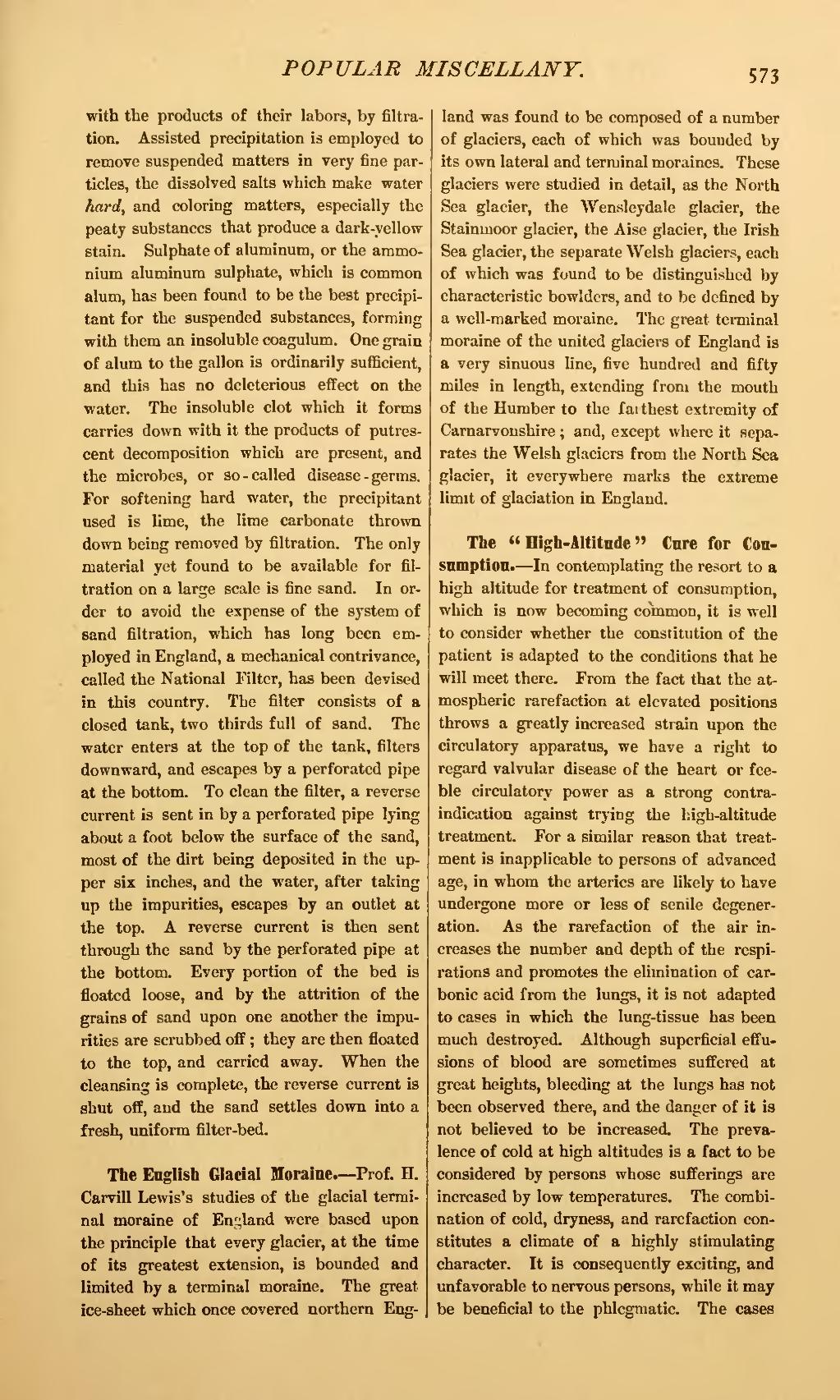with the products of their labors, by filtration. Assisted precipitation is employed to remove suspended matters in very fine particles, the dissolved salts which make water hard, and coloring matters, especially the peaty substances that produce a dark-yellow stain. Sulphate of aluminum, or the ammonium aluminum sulphate, which is common alum, has been found to be the best precipitant for the suspended substances, forming with them an insoluble coagulum. One grain of alum to the gallon is ordinarily sufficient, and this has no deleterious effect on the water. The insoluble clot which it forms carries down with it the products of putrescent decomposition which are present, and the microbes, or so-called disease-germs. For softening hard water, the precipitant used is lime, the lime carbonate thrown down being removed by filtration. The only material yet found to be available for filtration on a large scale is fine sand. In order to avoid the expense of the system of sand filtration, which has long been employed in England, a mechanical contrivance, called the National Filter, has been devised in this country. The filter consists of a closed tank, two thirds full of sand. The water enters at the top of the tank, filters downward, and escapes by a perforated pipe at the bottom. To clean the filter, a reverse current is sent in by a perforated pipe lying about a foot below the surface of the sand, most of the dirt being deposited in the upper six inches, and the water, after taking up the impurities, escapes by an outlet at the top. A reverse current is then sent through the sand by the perforated pipe at the bottom. Every portion of the bed is floated loose, and by the attrition of the grains of sand upon one another the impurities are scrubbed off; they are then floated to the top, and carried away. When the cleansing is complete, the reverse current is shut off, and the sand settles down into a fresh, uniform filter-bed.
The English Glacial Moraine.—Prof. H. Carvill Lewis's studies of the glacial terminal moraine of England were based upon the principle that every glacier, at the time of its greatest extension, is bounded and limited by a terminal moraine. The great ice-sheet which once covered northern England was found to be composed of a number of glaciers, each of which was bounded by its own lateral and terminal moraines. These glaciers were studied in detail, as the North Sea glacier, the Wensleydale glacier, the Stainmoor glacier, the Aise glacier, the Irish Sea glacier, the separate Welsh glaciers, each of which was found to be distinguished by characteristic bowlders, and to be defined by a well-marked moraine. The great terminal moraine of the united glaciers of England is a very sinuous line, five hundred and fifty miles in length, extending from the mouth of the Humber to the farthest extremity of Carnarvonshire; and, except where it separates the Welsh glaciers from the North Sea glacier, it everywhere marks the extreme limit of glaciation in England.
The "High-Altitude" Cure for Consumption.—In contemplating the resort to a high altitude for treatment of consumption, which is now becoming common, it is well to consider whether the constitution of the patient is adapted to the conditions that he will meet there. From the fact that the atmospheric rarefaction at elevated positions throws a greatly increased strain upon the circulatory apparatus, we have a right to regard valvular disease of the heart or feeble circulatory power as a strong contraindication against trying the high-altitude treatment. For a similar reason that treatment is inapplicable to persons of advanced age, in whom the arteries are likely to have undergone more or less of senile degeneration. As the rarefaction of the air increases the number and depth of the respirations and promotes the elimination of carbonic acid from the lungs, it is not adapted to cases in which the lung-tissue has been much destroyed. Although superficial effusions of blood are sometimes suffered at great heights, bleeding at the lungs has not been observed there, and the danger of it is not believed to be increased. The prevalence of cold at high altitudes is a fact to be considered by persons whose sufferings are increased by low temperatures. The combination of cold, dryness, and rarefaction constitutes a climate of a highly stimulating character. It is consequently exciting, and unfavorable to nervous persons, while it may be beneficial to the phlegmatic. The cases

